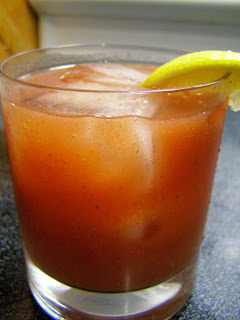When Fall arrives, I start making chicken stock again. Homemade chicken stock tastes better and is
far more nutritious than anything you can buy at the grocery store. And it's super easy to make. Really, I promise. Basically throw stuff in a pot and let it simmer....and enjoy the smells all day. Strain and freeze.
 |
| Chicken, garlic, onion, celery, carrots, herbs, peppercorns....add salt later after tasting. |
The biggest revelation for me was learning that I didn't need to peel things or chop them small. Just quarter that onion and throw it in (remove produce stickers and wash off any visible dirt, of course). Chop a head of garlic in half and add it. Throw in some carrot peels. This is going to simmer all day, and the peels will add a lovely color to the stock. If you plan ahead, you can have a
Stock Bag all ready to go! Use of a Stock Bag is quite thrifty and can add a wonderful depth of flavor because of the vegetable variety. I should caution you not to add purple cabbage, though, unless you want Barney-colored broth as my neighbor Abby discovered, much to her chagrin.
Making homemade stock -- especially if you use a Stock Bag -- is a wonderful way to
Use It All! Here in America,
we throw away vast quantities of edible food, and our house is (sadly) no exception, though we've cut waste dramatically in the last few years. Small changes make a difference! So if you have a few mushrooms that need to be used, but don't fit tonight's menu...toss them in the stock bag. Don't wait till it goes off and chuck it in the compost:
SAVE IT in the freezer until you can
USE IT.
 |
| The addition of some giblets to this batch produced a very small amount of foam which is easily removed. |
So...I never use fresh chicken for stock (except for giblets when I have them). Instead, when I roast a chicken (or very occasionally cook bone-in breasts or other parts), I save the carcass/bones in a plastic bag in the freezer and use those to make the stock. Most of the nutrition in homemade stock comes from the bones. You can put them on a sheet and roast them first for a richer color/flavor for the stock, but I am all about easy, so I never do this and my stock never suffers from flavor deficiency. We did make stock with a fried turkey carcass once and it was delish!
Note: if you do use fresh chicken, you'll want to put it in a pot of cold water, bring it gently to a simmer, and scoop off the foam, or "scum", that forms on the top. This foam is not harmful, but it will make your stock cloudy. So remove, Then add veggies and continue to simmer.
Here is the "recipe" I use:
1-2 chicken/turkey carcass(es), including giblets if available (excluding the liver)
Good glug of vinegar (to leach nutrients from the bones)
Bag of vegetable trimmings
Add quartered/halved fresh veggies if necessary -- I make sure to have roughly equal parts of onions, carrots and celery, and then I add some garlic
-- other veggies that work well include mushrooms, leeks, fennel, tomatoes, any greens, broccoli, zucchini, squash...you get the idea
Add fresh herbs if you have them (parsley, thyme are my favorites)
Add a shake of peppercorns
Add a bay leaf or two
Start it cold and slowly bring it up to a gentle simmer. It won't hurt it it it boils, but the "low and slow" will give you clearer stock in the end. Simmer for several hours stirring/tasting regularly. If you like, you can let the bones sit in cold water/vinegar for a half hour or so to pull even more calcium, gelatin and other nutrients from the bones. Once it has been simmering for an hour or so, I start to taste and add salt sparingly as it cooks. I do not add salt at the beginning because there are generally trace amounts on the carcasses from when I cooked them the first time. I prefer a lower-sodium broth, since I can always add salt based on what I'm making with it. Taste as you go to learn how the flavor develops!

Here you can see the stock after simmering for about five hours. The broth is developing a lovely color and the vegetables are quite soft. By now, little bits of meat will also float off the chicken bones and the carcass will come apart when I lift it with the spoon. This photo was taken at 4:30, so this stock will cook another hour or two until dinnertime, but I could certainly stop here if I wished.
When you decide it is done, turn off the heat and let it cool. Strain it through a colander, and put it in the refrigerator. The next day, you'll see that any excess fat will congeal on the surface in the fridge, so you can just scoop it off the next day. Sometimes I've made stock that had a jello-like consistency when cooled --
this is very nutritious and great for soup when someone is sick!
The final step is to strain it through cheesecloth and portion it into containers for the freezer. Nowadays I use wide-mouth glass jars instead of ziplock or plastick (just don't tighten the lids).
You can make vegetable stock by leaving out the meat. Ask at your grocery or market for beef bones or fish bones to make other types of stock.
Besides delicious soup, use your stock instead of (or half and half with) water when making rice, use it to make risotto, pan sauces, use in mashed potatoes with 2% milk instead of cream, cook veggies in stock, sub for wine in pasta sauce, it is
liquid gold baby!!


















































